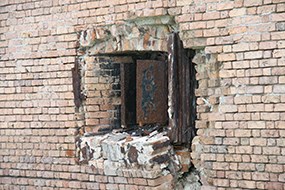
The founding legislation of Dry Tortugas National Park mandates the National Park Service to "protect, stabilize, restore, and interpret Fort Jefferson, an outstanding example of nineteenth century masonry fortification" for future generations. The fort is located in the Florida Keys where regular exposure to salt, heat, destructive weather, and water are a constant threat to the historic fabric of the fortification. 
Constructed between 1845 and 1876, Fort Jefferson is a 19th-century third system coastal fortification that occupies the majority of Garden Key in the remote Dry Tortugas National Park in the Florida Keys. Fort Jefferson represents the highest achievements of nineteenth century American military architecture and civil engineering. The latest technologies were incorporated into the fort design, including specialized iron shutters used to protect the cannon openings. First introduced into American forts in 1857, these hinged, wrought-iron shutters were placed between the mortar core of the fort and the brick façade. During use, the shutters were unlocked from the bronze strike plate below. Upon firing the cannon, gases escaping from the muzzle the moment before the egress of the shot would momentarily throw the shutters open. The shutters were carefully balanced so that they would swing freely and ‘rebound’ into the closed position. 
Unfortunately, the very metal that provided valuable protection to soldiers under fire proved devastating to the fort itself. In a saltwater environment, over time, the wrought-iron began to rust and expand. As the iron expanded, it pushed the brick apart, causing serious structural damage to Fort Jefferson's walls. A walk around the moat shows where large sections of the fort walls have collapsed into the moat due to this issue, compounded by the hostile coastal environment. 
The degradation and loss of historic fabric will continue to occur and contribute to on-going safety and structural issues of this important historic structure until the iron shutter assemblies are removed. Once the outer protective brick surface has fallen, costly repairs are necessary. In time, the lack of preventive maintenance and continued degradation could potentially threaten the structural integrity of the casemates and, eventually, the legislative mandate of the Park’s enabling legislation to “preserve for future generations”. The NPS is not trying to rebuild Fort Jefferson; but rather, are trying to mitigate the effects of the environment over time on this structure by removing the corroded iron Totten shutter assembly components and stabilizing the masonry in order to preserve the form and materials for future generations to learn from, experience, and enjoy. 
The stabilization process began more or less as trial and error back in the 1980’s. In the early phases this scale of work on a third system fortification was rare. Additionally, the location and logistics involved with any undertaking at the Dry Tortugas is challenging and costly. The process has continued to improve and progress with each phase of stabilization. The staff todays feels that they are leading the way within the NPS and among these niche structures; third system fortifications; and on a larger scale with unreinforced masonry stabilization with their extensive testing of materials and the search for compatible replacement materials needed to undertake these repairs. The actual process of dismantling and reassembling the embrasures and shutter components and the general reconstruction of the scarp walls and parapet has been extensively documented for recordation, future projects, and information sharing with other organizations, parks, and forts. The NPS is planning to have all the original shutter assemblies removed and replicated and exterior walls stabilized by 2020. As you walk around the moat during your time at the fort, see if you can identify different areas of the exterior scarp wall that have been stabilized over time. Additional Links |
Last updated: June 7, 2018
